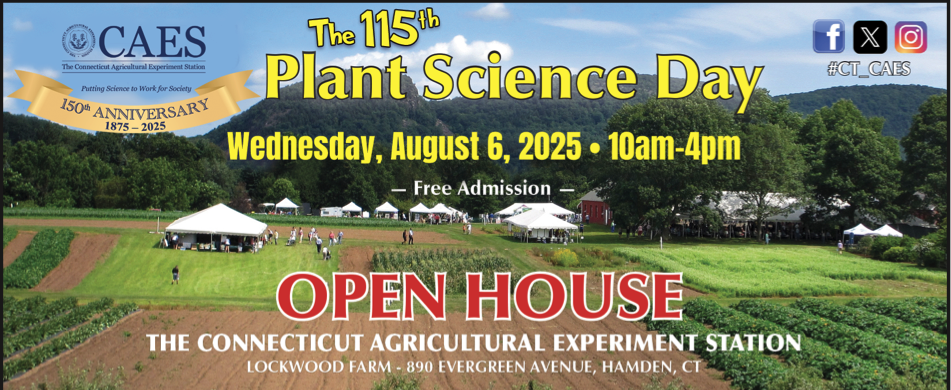What to be on the lookout for…
Tomato Fruitworm
Recent scouts of field tomatoes as well as tunnel grown tomatoes indicate that damaging populations of tomato fruitworm (TFW) are on the rise. TFW, known by the scientific name Helicoverpa zea or by its more common name - the corn earworm, feed directly on tomato fruit. They enter as larva and can cause damage to three or four tomatoes by the time of full maturity. In addition to tomatoes and corn, this insect can also attack tomatillos, peppers, beans, peas, okra, along with other field crops.
Products containing spinosad will help to control fruit worms but timing is critical as chemical sprays will not impact TFW when they are inside a fruit. Damaged fruit will ripen prematurely. Control of TFW populations is important to minimize secondary pests like mites or aphids. See the New England Vegetable Management Guide for spray options.

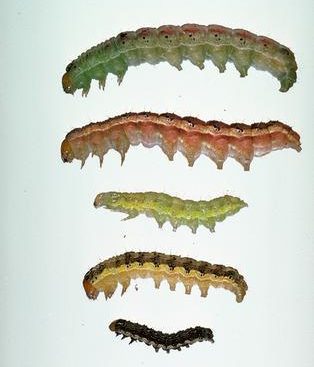
Blossom End Rot (BER) on Tomatoes and Peppers
Regular, constant moisture is the best prevention of BER. Research from Cornell Vegetable Program has showed that increased levels of calcium in the soil are not correlated with increased calcium levels in the plant. In most cases, there is no need to apply additional calcium as a foliar spray or through fertigation. The problem is getting the calcium from the roots to all parts of the plant. Therefore, water management to keep the soil moisture consistent is the best strategy to reduce BER. Removing fruit with BER can reduce further losses as even damaged fruit will continue to mature and compete for the plant’s nutrients. The same is true for pepper crops.
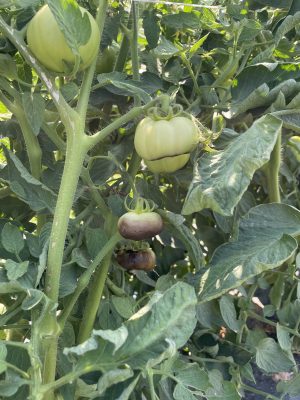
Pepper Maggots
Be on the lookout for pepper maggots as they are currently active and laying eggs across the northeast (oviposition pinhole marks seen on crops in MA, VT, and NH). Cherry peppers are a good indicator crop. Females insert their eggs directly into the pepper fruit and leave a small dimple or scar. Yellow sticky traps baited with a vial of 28% ammonium hydroxide may be used to capture adult flies if hung in nearby trees. Traps are most reliable when hung about 20' high, within the canopy of maple trees bordering the field. Make 2 to 3 applications at 5 to 10 day intervals beginning 1 week after oviposition scars are detected or when the first fly is captured.
See the New England Vegetable Management Guide for spray options targeting pepper maggots.
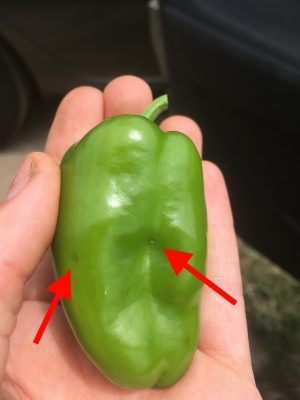
Sunscald on Peppers
From 200From 2006 to 2023, the UV Index rating in July has averaged 9 (on a scale of 1-11+), the most intense month of the year. Charting of the UV Index in 2025.png shows that both June and July have had daily ratings between 8-10+. Categorically this indicates “very high” exposure, just one rating below the highest, "extreme". While pepper crops like the heat, intense sunlight and UV radiation, especially on fruit that isn’t protected by the plant’s leaf canopy, can put the fruit at risk of sunscald. Sunscald is not only damaging to the affected fruit, but it also opens the door to pathogens making the entire plant vulnerable to infection. Additional fruiting crops particularly susceptible to sunscald include tomatoes, cucumbers, eggplant, pumpkins, and squash. Leaves may also be impacted by intense sun. The damage can be identified by foliage bleaching or browning.
Shading is the best protection against sunscald. Be mindful of plants that may have fallen over and add trellising so the fruit can benefit from foliar shade. When selecting varieties, seek out cultivars with thicker plant canopies.
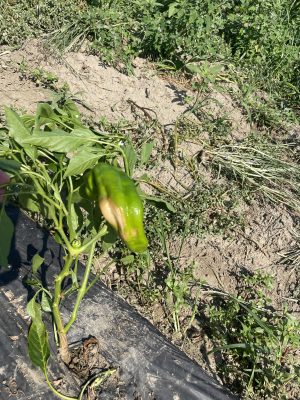
Sweet Corn Pests - Trap Count Update
| Location | CEW (avg per night) | ECB - NY | ECB - IA | ECB - III | FAW |
| Glastonbury A | .6 | 0 | 0 | 1 | 0 |
| Glastonbury B | .5 | 3 | 1 | 0 | 9 |
| Berlin | .16 no spraying required |
0 | 0 | 0 | 0 |
Note: We caught wainscot moths in FAW traps and spongy moths in ECB traps. Accurate ID of moths in traps is important. View our Sweet Corn Pest ID Guide.
Squash Vine Borer Trap Count (Berlin): 2
Spray intervals for CEW can be found on our website. See the New England Vegetable Management Guide for management strategies for all sweet corn insect pests.
Notice to CT Fertilizer and Soil Amendment Registrants from CT DoAG
The Connecticut Department of Agriculture recently sent a letter to all registrants concerning a legislative update regarding the use of PFAS. Details of that letter are included below:
Effective July 1, 2025: Section 21 of PA 25-152 (amending C.G.S. 22a-903c) PFAS Ban in Fertilizers is added to Existing Ban of PFAS in Soil Amendments
No person shall use, sell or offer for sale in this state any fertilizer intended for land application or soil amendment that contains any biosolids or wastewater sludge that contain PFAS.
If your fertilizer or soil amendment product contains biosolids, you must provide a certificate of compliance stating that the product does not contain PFAS. This proof of compliance must be furnished by the product’s manufacturer or supplier to the Connecticut Department of Agriculture at the time of product registration or renewal.
Any such certificate of compliance shall be signed by an authorized official of the manufacturer or supplier.
A certificate of compliance shall be kept on file by the manufacturer or supplier of the fertilizer or soil amendment.
In order to comply with this new law, send a certificate of compliance to AGR.Commodities@ct.gov for your fertilizer and soil amendment products that contain biosolids by August 31, 2025, OR remove your fertilizer and soil amendment products containing biosolids from Connecticut stores by August 31, 2025. Failure to do so will result in violation notices and stop sales.
Any further questions can be directed to AGR.Commodities@ct.gov.
Resource: Managing Flood Risks on Farms
Our team at UConn Extension has put together a factsheet to help you navigate flood risks on your farm. From preparing before a big storm to dealing with the aftermath, this short guide covers practical steps to help protect your crops, soil, and equipment. With more extreme weather events happening across the region, it's a good time to think about how to reduce damage and recover safely if flooding occurs.
Read the factsheet: Managing Flood Risks on Farms
Additional State Resources:
Continue to be on the lookout for the following pests...
Want the New England Vegetable Management Guide and/or Northeast Vegetable and Strawberry Pest ID Guide at your fingertips?
The Connecticut Agricultural Experiment Station’s Plant Science Day is held at Lockwood Farm on the first Wednesday of August every year, beginning in 1910. This one-day event features reports on research, opportunity for pesticide credits, field plots, barn exhibits, tours, and other opportunities for Connecticut residents and attendees to discuss many topics of plant science on an informal basis and interact with CAES scientists and staff.

Stay in touch with us
- Share what you see: We're here to assist with identification, management strategies, and guidance on best practices. Send us a photo/message via text at 959-929-1031.
- Facebook Group: UConn Extension moderates a private Facebook group specifically for commercial vegetable producers. It is a space to share photos of insects and diseases you find in your fields, ask questions, share ideas, and stay engaged with growers across the state. Join the "UConn Extension - Vegetable IPM" Facebook Group
- Schedule a consultation: Would you benefit from meeting with an Extension Specialist at your farm to provide insight on pest or disease identification, management strategies, and more? If so, please contact our Vegetable Extension Specialist, Shuresh Ghimire, to setup a farm visit. Contact him at shuresh.ghimire@uconn.edu or 860-870-6933.
Contact Information
Shuresh Ghimire, Vegetable Extension Specialist: shuresh.ghimire@uconn.edu
Nicole Davidow, Vegetable Extension Outreach Assistant: nicole.davidow@uconn.edu
Vegetable IPM Office Phone Number:
860-870-6933
Vegetable IPM Cell Phone Number:
959-929-1031 (feel free to text/iMessage photos)
Vegetable IPM Pest Alert Audio Recording:
860-870-6954
Thank you for reading!
This report was prepared by Nicole Davidow, Outreach Assistant, and Shuresh Ghimire, Commercial Vegetable Specialist, UConn Extension.

The information in this document is for educational purposes only. Any reference to commercial products, trade or brand names is for information only, and no endorsement or approval is intended. Always read the label before using any pesticide. The label is the legal document for product use. Disregard any information in this report if it is in conflict with the label. UConn Extension does not guarantee or warrant the standard of any product referenced or imply approval of the product to the exclusion of others which also may be available. The University of Connecticut, UConn Extension, College of Agriculture, Health and Natural Resources is an equal opportunity program provider.

